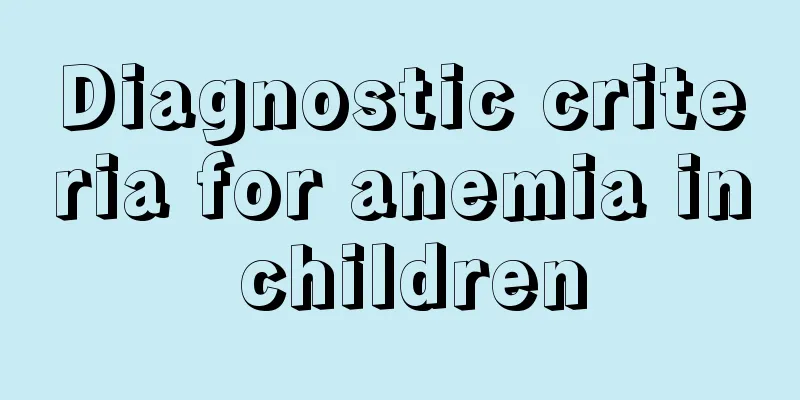Diagnostic criteria for anemia in children

|
Anemia is a symptom that has a great impact on human health and has a particularly high incidence rate, especially among children, many of whom suffer from anemia symptoms. Anemia is divided into three types according to the cause: nutritional iron deficiency anemia, nutritional megaloblastic anemia, and hemolytic anemia. The diagnostic criteria are different for different anemia symptoms. The following is some relevant knowledge. 1. Nutritional iron deficiency anemia (1) Blood picture: mainly characterized by decreased hemoglobin level. The red blood cell count does not decrease in the early stages of anemia, but decreases as the disease progresses. The mean corpuscular volume is smaller than normal, and the mean corpuscular hemoglobin content and mean corpuscular hemoglobin concentration are both reduced. The reticulocyte count was normal. Blood smears show that red blood cells are of different sizes and the central light-stained area is enlarged. Red blood cell fragility is reduced. (2) Iron metabolism examination: serum iron is decreased. Serum total iron binding capacity increased. Serum iron saturation decreased significantly. (3) Bone marrow image: Bone marrow nucleated cells proliferate actively, and in severe cases, proliferation may also be low. The ratio of granules to red cells is normal or the latter increases. Among the erythrocyte system, the increase of immature and late immature erythrocytes was most obvious. The cell bodies of red blood cells in each stage are relatively small, with less cytoplasm and blue staining, indicating that the cytoplasm is less mature than the nucleus. Prussian blue staining can show a decrease in sideroblasts, often below 1.5%. There were no special changes in the leukocyte system. Megakaryocytes are mostly normal. 2. Nutritional megaloblastic anemia (1) Peripheral blood shows macrocytic normochromic anemia, MCV>94fl, MCH>32pg. Red blood cells vary in size, with large cells being the main ones. White blood cell and platelet counts are often reduced, and neutrophil nuclei are hypersegmented. Reticulocytes are mostly normal. (2) Bone marrow proliferation is obviously active, with megaloblastic changes in both the granulocyte and erythroid systems, showing "immature nuclei and old plasma", and the megakaryocyte nuclei are overly lobed. (3) Serum vitamin B12 and folic acid determination: Vit B12 <100pg/L, folic acid <3μg/L. 3. Hemolytic anemia (1) First, look for evidence of hemolysis and compensatory hyperplasia to confirm the presence of hemolysis Evidence of hemolysis: ① Decreased hemoglobin, deformation and fragmentation of peripheral red blood cells; ② Increased serum indirect bilirubin; ③ Intravascular hemolysis can be seen in hemoglobinuria, hemoglobinemia (plasma appears pink to the naked eye) and hemosiderinuria. Evidence of compensatory bone marrow hyperplasia: ① A significant increase in reticulocytes; ② Peripheral blood smears show nucleated red blood cells, stippling and polychromatic red blood cells, granulocytosis, left shift of the nucleus, and occasional leukemoid reactions; ③ Obvious active bone marrow hyperplasia. Mainly red. (2) Determine the cause of the disease: ① Abnormalities in the red blood cell membrane: abnormal morphology of peripheral red blood cells, including spherical cells, ellipsoidal cells or stomatocytes. The diagnosis can be confirmed by red blood cell osmotic fragility test, acidified glycerol dissolution test, and red blood cell membrane protein analysis. ② Abnormalities of erythrocyte enzymes: Various erythrocyte enzymes can be measured, such as G-6-PD enzyme, pyruvate kinase, etc. ③ Abnormal hemoglobin: target cells can be seen in blood smear. Hemoglobin electrophoresis and anti-alkali hemoglobin determination can be performed. ④ Immune hemolysis: Red blood cell surface antibody determination and anti-human globulin (Coombs') test. A positive result can be confirmed as immune anemia; a negative result may be due to abnormal red blood cell membrane, abnormal red blood cell enzyme, abnormal hemoglobin, as well as drugs, physical and chemical factors, infection, etc. |
<<: There is a small lump behind the child's ear that does not hurt
>>: A child's hand is swollen after being bitten by a mosquito
Recommend
What to do if your child has a cough
Children may cough due to choking. Cough is one o...
Children catch cold
It is very common for children to catch colds bec...
Can babies use moxibustion?
Modern people pay more and more attention to heal...
What causes ADHD in children?
Attention deficit hyperactivity disorder (ADHD) i...
Baby often wets the bed at night
Bedwetting is a very common phenomenon in infancy...
What are the consequences of brain hypoxia in children?
As we all know, the human brain needs a constant ...
What to eat to reduce fever in children
If a child gets a fever, parents will become very...
What to do if your one-year-old baby is deficient in zinc and calcium?
Many mothers are very concerned about the physica...
Why do children's nails turn white?
Many adults always ignore the changes in children...
Children's rubbed legs syndrome?
Parents must observe their babies carefully when ...
What should I do if my newborn baby hiccups? This works great!
Many babies will burp and spit up milk, and many ...
What should I do if my baby has gastroenteritis?
Gastrointestinal diseases have a long-term impact...
What is hydronephrosis in infants?
Infant hydronephrosis is a common disease in the ...
What characteristics does the baby inherit from his parents?
When looking for a partner, look for someone who ...
The dangers of tympanitis in children
Tympanitis is a very common disease. This type of...









